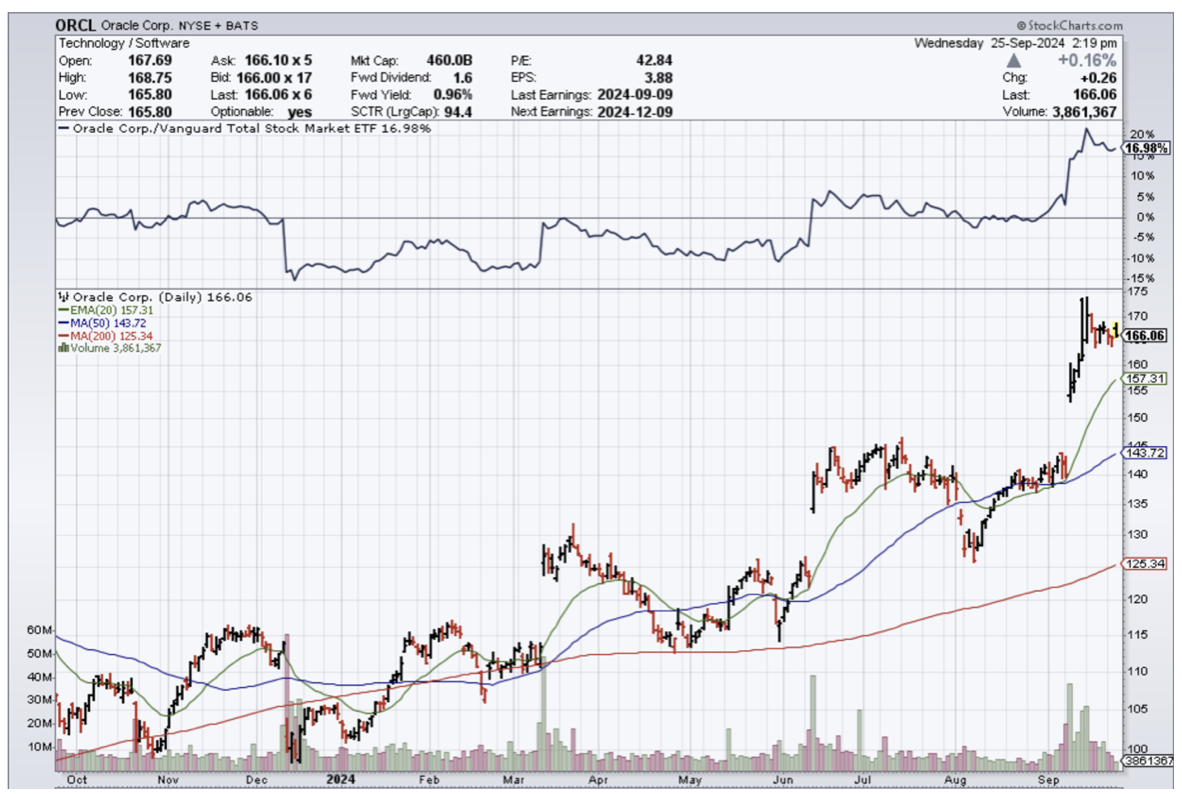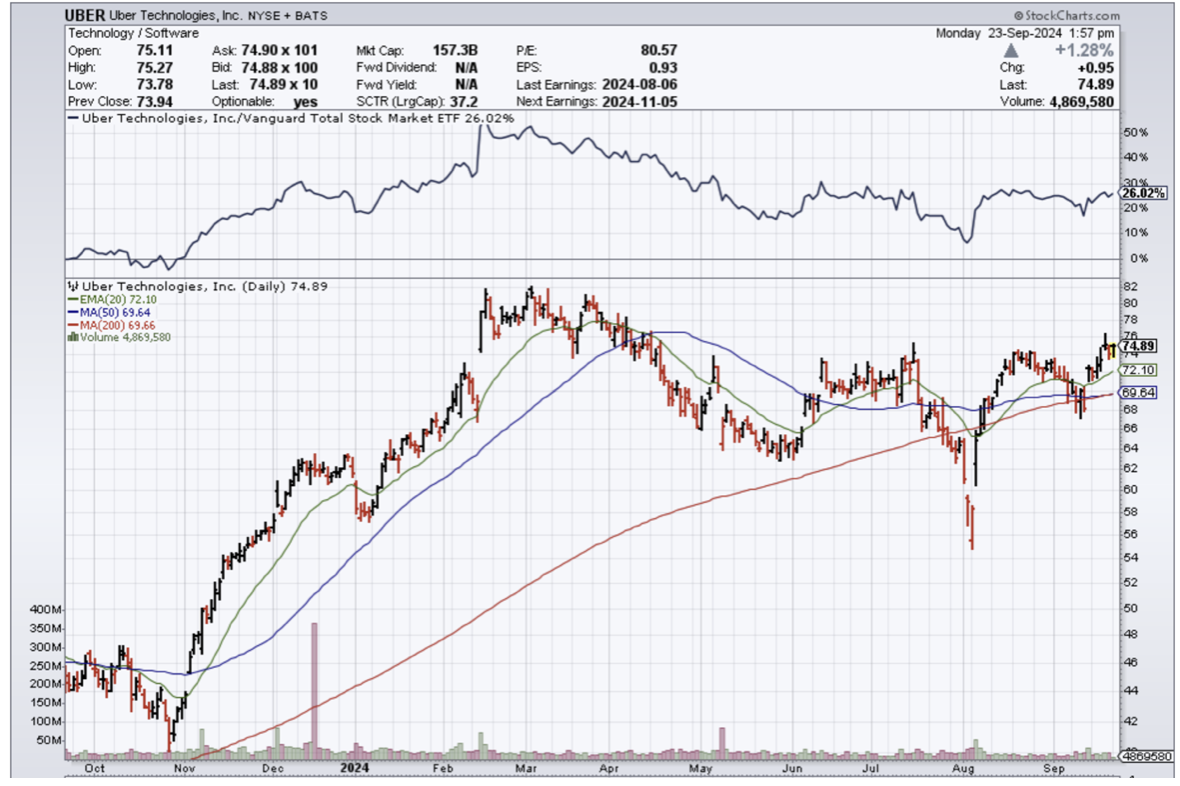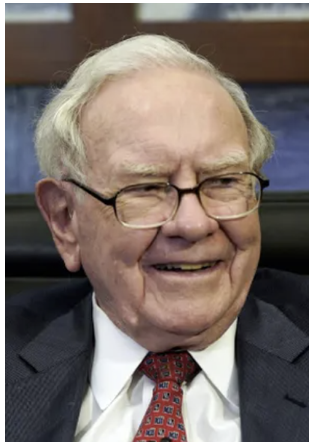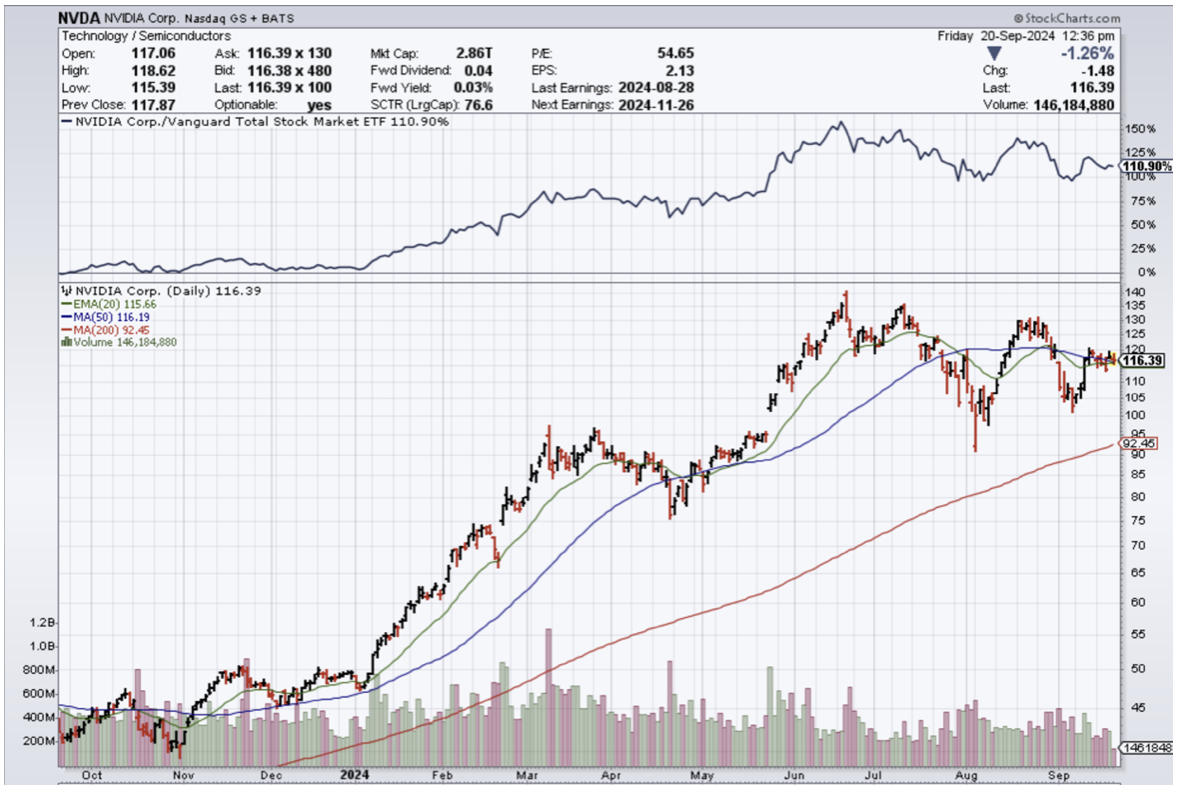Mad Hedge Technology Letter
September 25, 2024
Fiat Lux
Featured Trade:
(FROM 85 to 2,000 AI DATA CENTERS)
(ORCL), (NVDA)

Mad Hedge Technology Letter
September 25, 2024
Fiat Lux
Featured Trade:
(FROM 85 to 2,000 AI DATA CENTERS)
(ORCL), (NVDA)

Oracle plans to increase their amount of AI data centers from its current 85 to 2,000.
That is the most important number to take away from an analysts meeting with Oracle management.
Readers should ride on the coattails of this AI data center firm as throw billions upon billion at increasing the amount of AI infrastructure.
Readers absolutely need to know that a great swath of tech is dead and not innovating - growth rates collapsing faster than the U.S. birth rate.
It is important to position yourself at the cutting edge of innovation and growth and that is precisely companies who are knee deep in AI data center infrastructure investments that includes chip companies that produce GPUs like Nvidia.
In fact, Nvidia supplies Oracle and most other tech companies with data center chips called graphics processing units (GPU).
Nvidia has experienced an eye-popping surge in its revenue over the past year, and GPU demand continues to outstrip supply.
Oracle's data centers are unique because they are automated. Each one is operationally identical regardless of its size, and since they don't require human workers, it allows the company to build them quickly. Plus, Oracle's RDMA (random direct memory access) GPU networking technology allows data to flow from one point to another more quickly than traditional Ethernet networks.
Oracle has 85 data centers up and running with 77 more under construction as of the end of August.
Next year, Oracle intends to offer a cluster of 131,072 GPUs, which is a big step up from its largest clusters now, at around 32,000 GPUs. But there's another difference:
The new cluster will use Nvidia's latest Blackwell chips, which can perform AI inference at 30 times the pace of its flagship H100, which Oracle currently uses. Theoretically, it's going to allow developers to build the largest AI models in history.
In fact, Oracle spent $6.9 billion on data center infrastructure in 2024.
Oracle is going after the best technology in Nvidia’s Blackwell chip which is a solid reason to get interested in Oracle stock.
I don’t believe AI infrastructure spend will dissipate anytime soon and as the rest of the tech sub-sector growth falters, this one little area of AI will hold up the rest of tech.
This is why we are seeing extreme concentration of outperformance in just a handful of tech names and I don’t believe we will experience a scenario of spreading the wealth around to the less growth oriented subsectors.
In fact, I think the concentration will become even more outsized in a handful of names as a winner takes all mentality wins out in the tech sector.
We are just scratching the surface in what will become a massive explosion of AI data centers everywhere to satisfy the extreme demand of computing that it will require to pull this off.
Nothing indicates that this would be the wrong trend to follow and that assumption follows through to the astronomically high stock prices of the companies involved.
Oracle is one of these companies that readers should not dismiss.
It is at the heart of the AI infrastructure story that has legs.

"The only way to get ahead is to find errors in conventional wisdom." – Said Larry Ellison

Mad Hedge Technology Letter
September 23, 2024
Fiat Lux
Featured Trade:
(BE CAUTIOUS ABOUT STOCKS TIED TO GIG WORK)
(UBER)

I do believe companies heavily involved with gig workers will not experience a boon in the stock price in the near future.
Consumers are tapped out and there is not much more pricing power they can pass on to manufacture higher profits in the short run.
There is a chance the tide will rise with all boats, but I would wait this one out in gig work stocks.
As a cultural phenomenon, the gig economy is here to stay until they get muscled out by technology.
Americans are used to the 24-hour on-demand goods and services offered by gig workers.
The number one expense line item for these tech companies is labor.
They are actively working to try and reduce the burden.
I believe they are holding out until the vaunted robotaxi is green-lighted.
This change will crater labor expense to a pittance with most of the labor costs flowing towards the managers and executives.
It is the holy grail of the tech industry and we are rapidly approaching this inflection point.
These companies have come a long way.
In 2010, the smartphone application offered a new competitor to the taxicab industry by linking a paying passenger with a private driver using his or her own car.
The largest services are still focused on transportation. Uber and Lyft dominate the on-demand ride business.
Massive retailers like Walmart and Amazon joined in with their own on-demand platforms: Spark Driver and Amazon Flex.
Gig workers are recruited with the situation of flexible hours to earn additional income. However, as independent contractors, gig workers are not entitled to traditional employment benefits like health insurance, and they must take on additional occupational risks, equipment costs, and tax burdens.
In a 2024 economic impact report, Flex, a federal lobbying association supported by DoorDash, Grubhub, HopSkipDrive, Instacart, Lyft, Shipt, and Uber, estimated there were about 7.3 million “active drivers and delivery partners on major rideshare and delivery platforms” in 2022.
A 2022 report published by the consultancy McKinsey & Co. surveyed workers and estimated as many as 58 million Americans, or 36 percent of the U.S. workforce, did some gig work that year.
In its Securities and Exchange Commission filings, Uber describes the classification of its drivers as “employees, workers, or quasi-employees” as an “operational risk” to its business. The same document details the various legal and political challenges involved in maintaining independent contractor status.
Uber’s latest quarterly filing, published in August, said that if drivers win the reclassification through legal means or the passage of new laws, the company would incur significant expenses for compensating drivers and would pass its elevated costs onto riders. Uber also argues reclassification would limit its ability to find workers due to a loss of flexibility.
Uber is smart at attempting to root out the labor expenses. If robotaxis are integrated into the business model, the stock would increase by 500%.
In the meanwhile, workers forget ahead hoping to procure more benefits from Uber.
Uber is hell-bent on avoiding the financial toll of paying full-time workers and will indefinitely try to pin the label of independent contractor on its workers.
This existential threat will end up in courtrooms and Uber has good enough lawyers to stall out the lawsuits.
All eyes are on Tesla and Elon Musk to give insight into what the future of gig work and autonomous transportation looks like.
Uber knows it cannot maintain the status quo and something must be done to cut labor costs.
If that does happen, the stock will quadruple in short time.
As for the short-term, buy big dips in Uber stock.

“The best investment you can make is in yourself.” – Said Warren Buffett

Mad Hedge Technology Letter
September 20, 2024
Fiat Lux
Featured Trade:
(TECH STOCKS RECEIVE A GIFT)
($COMPQ), (NVDA)

No recession – highly bullish for technology stocks ($COMPQ) in the short term.
That is my hot take from Jerome Powell’s and the Fed’s surprise 50-point basis interest rate cut.
Tech stocks will overwhelmingly outperform the rest of the equity market because that is where the profits and earnings are.
I don’t see a situation for the ‘catch up’ trade, or if it does transpire, it will be very transitory in nature.
There is no other subsector that is about to overtake technology in terms of prestige or growth, and that is where I take comfort in believing that technology will harvest the lions’ share of the gains from the Central Bank’s interest rate cut.
The cut was a jumbo one, which means even better projections for tech share prices in the short run.
It is hard not to take a look-in back at the Magnificent 7 for another winter rally that should take the Nasdaq quite a bit higher from here.
That is why I executed a deep-in-the-money call spread on chip behemoth Nvidia (NVDA) this morning.
The tech-weighted Nasdaq index hit an all-time high in 2024 around July, with prices trading around 18,700 points, and we are around 5% from that high.
Any pullback in quality tech firms will be brought up, and I urge readers to enjoy the rally because of the unexpected jumbo hike, the rally is now pulled forward.
Highlighting the hawkish cut was the FOMC vote was 11-1, with Governor Michelle Bowman preferring a quarter-point move.
Powell pushed through a half-point move instead and ironically told reporters that the economy was great.
Unemployment numbers of around 4.2% were once considered full employment back in the day.
A half-point cut into a strong economy to pre-empt a recession is an interesting move.
It is clear they don’t want to get behind the curve after they badly botched inflation on the way up.
In most normal cases, tech stocks would rocket higher, and bond yields would sink, but the 10-year yield has gone the other way, signaling that this hawkish cut could ignite another bout of higher inflation at the long end of the yield curve.
The Nasdaq index gained 3%, showing that it can power through no matter what bonds are doing, and that has been the case since 2020.
The Japanese yen also shot higher from the 140 level to the 144 to the US dollar today.
A weaker trending yen is a highly bullish signal for the trajectory of U.S. tech stocks.
The committee expects the long-run neutral rate to be around 3%, a level that has drifted higher as the Fed has struggled to get inflation down to 2%.
Gross domestic product has been rising steadily, and the Atlanta Fed is tracking 3% growth in the third quarter based on continuing strength in consumer spending. Moreover, the Fed chose to cut even though most gauges indicate inflation well ahead of the central bank’s 2% target. The Fed’s preferred measure shows inflation running around 2.5%, well below its peak but still higher than policymakers would like.
The current jobless level is 4.2%, drifting higher over the past year, though still at a level that would be considered full employment.
A 50 basis point rate cut into an economy growing 3% per year will surely get GDP moving closer to 4%.
Think about it in terms of housing and all the buyers waiting on the sidelines waiting to get into the housing market.
Inflation is sure to come back again in the long term, but in the short term, this nudges 3% GDP to 4%, and that is highly bullish for tech stocks. This also should help unemployment stick close to the 4.2% in, which the Fed is worried about, which is a victory for equity markets.
The tech rally is here, and don’t miss out on it!

“It takes 20 years to build a reputation and five minutes to ruin it.” – Said American Investor Warren Buffett

Mad Hedge Technology Letter
September 18, 2024
Fiat Lux
Featured Trade:
(ORACLE’S PLAN TO DOMINATE AI)
(ORCL)

Legal Disclaimer
There is a very high degree of risk involved in trading. Past results are not indicative of future returns. MadHedgeFundTrader.com and all individuals affiliated with this site assume no responsibilities for your trading and investment results. The indicators, strategies, columns, articles and all other features are for educational purposes only and should not be construed as investment advice. Information for futures trading observations are obtained from sources believed to be reliable, but we do not warrant its completeness or accuracy, or warrant any results from the use of the information. Your use of the trading observations is entirely at your own risk and it is your sole responsibility to evaluate the accuracy, completeness and usefulness of the information. You must assess the risk of any trade with your broker and make your own independent decisions regarding any securities mentioned herein. Affiliates of MadHedgeFundTrader.com may have a position or effect transactions in the securities described herein (or options thereon) and/or otherwise employ trading strategies that may be consistent or inconsistent with the provided strategies.
This site uses cookies. By continuing to browse the site, you are agreeing to our use of cookies.
OKLearn moreWe may request cookies to be set on your device. We use cookies to let us know when you visit our websites, how you interact with us, to enrich your user experience, and to customize your relationship with our website.
Click on the different category headings to find out more. You can also change some of your preferences. Note that blocking some types of cookies may impact your experience on our websites and the services we are able to offer.
These cookies are strictly necessary to provide you with services available through our website and to use some of its features.
Because these cookies are strictly necessary to deliver the website, refuseing them will have impact how our site functions. You always can block or delete cookies by changing your browser settings and force blocking all cookies on this website. But this will always prompt you to accept/refuse cookies when revisiting our site.
We fully respect if you want to refuse cookies but to avoid asking you again and again kindly allow us to store a cookie for that. You are free to opt out any time or opt in for other cookies to get a better experience. If you refuse cookies we will remove all set cookies in our domain.
We provide you with a list of stored cookies on your computer in our domain so you can check what we stored. Due to security reasons we are not able to show or modify cookies from other domains. You can check these in your browser security settings.
These cookies collect information that is used either in aggregate form to help us understand how our website is being used or how effective our marketing campaigns are, or to help us customize our website and application for you in order to enhance your experience.
If you do not want that we track your visist to our site you can disable tracking in your browser here:
We also use different external services like Google Webfonts, Google Maps, and external Video providers. Since these providers may collect personal data like your IP address we allow you to block them here. Please be aware that this might heavily reduce the functionality and appearance of our site. Changes will take effect once you reload the page.
Google Webfont Settings:
Google Map Settings:
Vimeo and Youtube video embeds:
